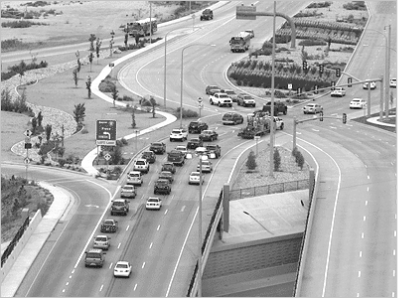
FHWA Alternative Intersections: Summary
The Department of Transportation and Federal Highway Administration (FHWA) had rolled out a series of alternative intersection designs in several states across the country. These alternative intersection designs proved to be safer, greener, more efficient and less expensive to build than standard intersection designs. Building on the success of the initial rollout, Federal Highway wanted to encourage other states, communities and transportation stakeholders to consider the new designs for upcoming projects.
Challenges
The audience for these outreach programs spanned from experienced traffic engineers to state and local transportation agencies as well as community stakeholders. The challenge was to produce compelling programming and print materials to build awareness about innovations in intersection designs, something that most of us thought had been “settled” long ago. Creatively, one obstacle that dogged us was how to illustrate the advantages of the new intersection designs when the physical size and traffic flow of the intersections were nearly a mile long.
Solutions
In the fall of 2013, PenBay Technology Group working with SAIC (now Leidos) conceived, produced and delivered four primary video programs about Alternative Intersections for FHWA as well as another twelve video case studies of selected Alternative Intersections. Working closely with the Alternative Intersections team at Leidos, PenBay Technology Group refined the list of intersections, and plotted the logistics of covering as many intersections as possible with an FFP budget. Given the varied locations, great effort was focused on making the logistics as efficient as possible. The PenBay Technology Group team filmed at about fifteen locations in Michigan, Utah, Missouri, Washington DC, Georgia and North Carolina.
PenBay Technology Group assembled a small, efficient team of videographers and subject matter experts to travel to each Alternative Intersection site. Logistics were critical as the planning had to account for weather days, local access and permissions, and of course safety concerns for the people on the ground as well as the local drivers.
We leveraged our technical video capture skills to make the production as efficient as possible not only on the ground but throughout the editing as well. For example, the on-location videographers ensured that the two camera crews were always “timecode locked” to each other so when the editors were cutting the two programs it was immediately possible to locate a corresponding and synchronous alternate angle from the other camera team. This simplified the edit enormously and made the answer easy when the client asked to “see if we had another angle” of some driver action.
PenBay Technology Group supplemented the terrestrial video capture with aerial footage filmed from helicopters. We located, hired and rigged helicopters in Michigan, Salt Lake, Washington DC and Atlanta. After evaluating the budget limitations and the number of varying intersection types available in Salt Lake County, we chose to film with a gyro stabilized mount (CineFlex) during the filming in Utah. The CineFlex technology (made famous in the BBC documentary, Planet Earth) is a very effective means of stabilizing what would otherwise be shaky aerial footage into a dead still, almost eerie, eye in the sky. The gyro stabilized footage was a critical element in the outreach materials for each of the four intersection types that we featured.
"PenBay repurposed the original six videos to create twelve additional case studies. Terrific client value!" -- FHWA
| CLIENT | US Federal Highway Administration |
|---|---|
| DATES | 8/2013-1/2014 |
| VIDEO | https://vimeo.com/99668499 |
| SKILLS | Conceptual Development Scriptwriting Logistics and Pre Production Aerial Rigging and Cinematography Editorial Video Editing |

